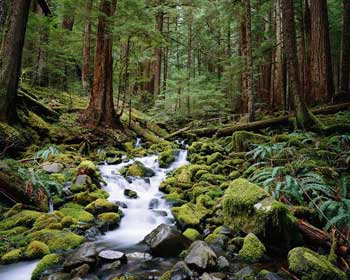Forest fragmentation poses a serious and growing threat to the ability of forests to support wildlife, and provide clean air and water, recreational opportunities, and an economically viable source of wood products.
 |
Forest fragmentation can decrease water quality. |
Forest fragmentation occurs when large, contiguous blocks of forest are broken up into isolated islands by development, roads, or clearing for agriculture. Just as inbreeding among the royal families of Europe spread hemophilia, forest fragmentation negatively impacts the long term sustainability of both plant and animal communities. Geographic isolation results in inbreeding and diminishes biodiversity. Migratory pathways for birds are lost. The encroachment of roads into forests greatly increases the odds that animals that are migrating, or seeking food, partners or breeding habitat will end up as flattened fauna. Scientists also suspect that fragmentation harms many woodland birds by making them more susceptible to predation by jays, crows, raccoons, and cats – creatures not typically abundant in extensive forests. Negative interaction with homeowners can also occur, as hungry deer feast on landscape plants, and coyotes, fox and fishers chow on household pets.
Forest fragmentation can also decrease water quality, as homes and impervious surfaces such as roads and parking lots replace woodland plants, wetlands and soil that previously stored carbon dioxide, produced oxygen, absorbed pollutants and protected against erosion.
Breaking forests into small parcels can even impact human health. While fragments generally have fewer species than continuous habitat, some species like white-footed mice actually do better in small patches, probably because there are fewer predators and competitors left. White-footed mice populations are high in fragments smaller than about five acres, which could mean trouble for people living nearby, since the mice are the main carriers of Lyme disease bacteria. In one study, fragments smaller than three acres had an average of three times as many total deer tick nymphs as larger fragments did, and seven times as many infected nymphs. As many as 80% of the nymphs were infected in the smallest patches, the highest rate the researchers have seen.
Finally, forest fragmentation has an economic impact. From 1994 to 1997, new single-family homes consumed an average of 2.16 million acres per year of land not previously used for housing. As population increases in the countryside, farming and forestry decrease as the infrastructure that supported them moves away. When forests are broken into smaller and smaller parcels, the economy of scale for forest management is lost. The parcels are then broken up even more, in a downward spiral. By 2010, some 150 million acres of productive private forestland will be owned in parcels of 100 acres or less, and the average holding will be about 17 acres (Sampson 2000).
MORE INFORMATION:
- Forestry, Woodstock Conservation Commission
- Note: I wonder if forest fragmentation is resulting in increased House Wren populations.
|

